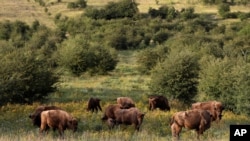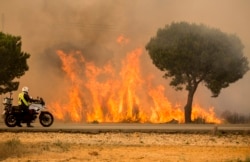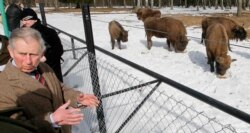The hulking, horned bison has long been an iconic symbol for people from the United States to eastern Europe.
They were worshipped as deities by the Native Americans and for the Polish, they are the most important animal after the double-headed eagle which adorns the national flag.
Cave paintings in Spain show they were an essential part of life on the Iberian Peninsula about 1.2 million years ago.
After being hunted nearly to extinction in the United States and Europe alike, the bison is undergoing a resurgence in terms of numbers.
Conservationists now believe that far from being a historical symbol, the bison may play a role in tackling some of the side-effects of the biggest problem facing mankind in the future– climate change.
Bison are herbivores that naturally feed on the undergrowth which fuels forest fires, a natural hazard as the world heats up.
Rising temperatures and rural depopulation among factors which are driving a rise in forest fires.
In Spain, wildfires have destroyed about 741,000 hectares of forest over the past ten years, according to government estimates.
Huge blazes are also becoming more common elsewhere in Portugal, California and Australia.
Since the 1950s, Spain has seen a slow drain of population from rural to urban areas that has left fewer flocks of sheep to eat the highly flammable scrubland as farms have been abandoned.
However, a new program to reintroduce bison, which were driven into extinction about 10,000 years ago, may hold out hope of a way to reverse this trend.
There are 18 centers breeding bison in Spain and over the past ten years their numbers have risen from 22 to just over 150.
The way the bison eats shrubs helps to open up dense parts of the forest, which lets in light and allows grass to grow instead of scrub which helps forest fires spread.
“These animals naturally eat the vegetation and this could act as a natural fire break. With less and less flocks of sheep or cows being farmed in open ground, bison would fill this gap,” Fernando Morán, a veterinarian who is director of the European Bison Conservation Center of Spain, told VOA.
European bison can weigh up to one ton and eat around 30 kilograms of vegetation per day.
When they were released into a 20-hectare oak forest in 2010, seven bison cleared the undergrowth, saving about $72,000 which it would have cost to pay engineers to do the same job.
No status
But, as bison have been extinct for so long, they are not recognized as an endangered species and so there is no state funding in Spain for these schemes which depend on donations.
The animals are also not permitted to roam wildly as they are not considered as an indigenous species in Spain so are kept in large parks.
Morán says politicians in Spain and beyond should realize the potential of the bison to restore the ecosystem and change the law so they can roam free once more.
“At present there is not the political will to make this change at present despite the pressure we have put on the government to do this,” he said.
Jesús Gonzalez was a miner who worked in the coalfields of northern Spain but now dedicates himself to promoting the cause of the bison at a reserve in San Cebrián de Muda, a tiny village of 162 inhabitants.
“This part of Spain has changed from an area which used to produce coal — which damages the environment – to one which nurtures animals like the bison which could play a role in helping the environment,” he told VOA in an interview from the reserve.
In eastern Europe, the bison is allowed to roam freely in Poland, Russia, Belarus, Ukraine, Slovakia, Romania and Lithuania. There is also state funding for its nurture in Romania and Poland.
Wanda Olech, a founder of the European Bison Friends' Society based in Warsaw in Poland, believes this animal, like all grazing animals, could help combat climate change.
She said the European bison has made such a recovery from the face of extinction that she advocates planned culls to prevent disease spreading.
“In Poland alone there are 2,300 bison alone, of which about 50 are blind so we must control these animals with professionally organized culls,” Olech, who is a professor of animal genetics, told VOA.
“This is not cruelty but should be professionally organized with hunters who could pay as they do in African countries.”
Projects to export the European bison to Chile were rejected as it was believed the animal would not adapt, so bison are not present in Latin America or Africa.








